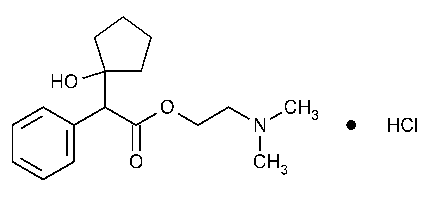Cyclopentolate Hydrochloride
Benzeneacetic acid,a-(1-hydroxycyclopentyl)-,2-(dimethylamino)ethyl ester,hydrochloride,(±)-.
2-(Dimethylamino)ethyl (±)-1-hydroxy-a-phenylcyclopentaneacetate hydrochloride [5870-29-1].
»Cyclopentolate Hydrochloride contains not less than 98.0percent and not more than 102.0percent of C17H25NO3·HCl,calculated on the dried basis.
Packaging and storage—
Preserve in tight containers,and store in a cold place.
Identification—
A:
Infrared Absorption á197Kñ.
B:
Asolution (1in 500)responds to the tests for Chloride á191ñ.
pHá791ñ:
between 4.5and 5.5,in a solution (1in 100).
Loss on drying á731ñ—
Dry it at 105 for 4hours:it loses not more than 0.5%of its weight.
for 4hours:it loses not more than 0.5%of its weight.
Residue on ignition á281ñ:
not more than 0.05%.
Chromatographic purity—
Buffer solution,Mobile phase,and Chromatographic system—
Prepare as directed under Assay.
Test preparation—
Use the Assay preparation.
Procedure—
Inject a volume (about 20µL)of the Test preparationinto the chromatograph,record the chromatogram obtained for a period of not less than twice the retention time of cyclopentolate,and measure the peak responses.Calculate the percentage of each peak,other than the solvent peak and the cyclopentolate peak,in the specimen of Cyclopentolate Hydrochloride taken by the same formula:
100ri/rt,
in which riis the response of each peak and rtis the sum of the responses of all of the peaks,excluding that of the solvent peak:not more than 1.0%individual impurity and not more than 2.0%total impurities are found.
Assay—
Buffer solution—
Dissolve 660mg of dibasic ammonium phosphate in 1000mLof water.Adjust with phosphoric acid to a pHof 3.0±0.1,and mix.
Mobile phase—
Prepare a suitable filtered and degassed mixture of acetonitrile and Buffer solution(7:3).Make adjustments if necessary (see System Suitabilityunder Chromatography á621ñ).
Standard preparation—
Dissolve an accurately weighed quantity of USP Cyclopentolate Hydrochloride RSin water,dilute quantitatively,and stepwise if necessary,with water,and mix to obtain a solution having a known concentration of about 0.1mg per mL.
Assay preparation—
Transfer about 100mg of Cyclopentolate Hydrochloride,accurately weighed,to a 100-mLvolumetric flask,dilute with water to volume,and mix.Transfer 5.0mLof this solution to a 50-mLvolumetric flask,dilute with water to volume,and mix.
Chromatographic system
(see Chromatography á621ñ)—The liquid chromatograph is equipped with a 220-nm detector and a 4.6-mm ×15-cm column that contains packing L15.The flow rate is about 2mLper minute.Chromatograph the Standard preparation,and record the peak responses as directed for Procedure:the column efficiency determined from the analyte peak is not less than 3000theoretical plates,the tailing factor for the analyte peak is not more than 2.0,and the relative standard deviation for replicate injections is not more than 2.0%.
Procedure—
Separately inject equal volumes (about 20µL)of the Standard preparationand the Assay preparationinto the chromatograph,record the chromatograms,and measure the responses for the major peaks.Calculate the quantity,in mg,of C17H25NO3·HCl in the portion of Cyclopentolate Hydrochloride taken by the formula:
1000C(rU/rS),
in which Cis the concentration,in mg per mL,of USP Cyclopentolate Hydrochloride RSin the Standard preparation;and rUand rSare the cyclopentolate peak responses obtained from the Assay preparationand the Standard preparation,respectively.
Auxiliary Information—
Staff Liaison:Lawrence Evans,III,Ph.D.,Scientist
Expert Committee:(PA6)Pharmaceutical Analysis 6
USP28–NF23Page 557
Phone Number:1-301-816-8389
